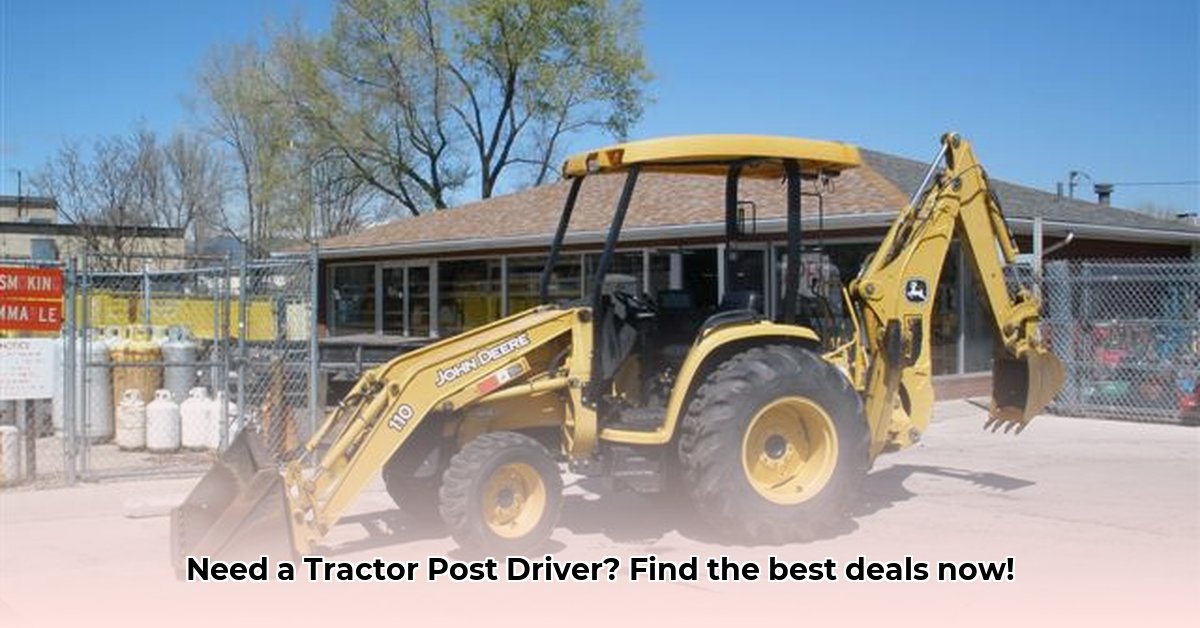
Finding the Right Tractor Post Driver Rental
Need to rent a tractor post driver? This comprehensive guide provides actionable advice to help you find the best equipment, ensure your safety, and complete your project efficiently. Whether you're a professional contractor or a DIY enthusiast, we'll navigate you through the process. For even more resources, check out this helpful tractor implement rental site.
Figuring Out Your Needs
Before beginning your search, assess your project's requirements. How many posts need driving? What's the soil type (sandy, clay, rocky)? These factors determine the necessary equipment size and power. A small project might suffice with a lightweight model; larger projects or challenging terrain necessitate a more powerful machine. Think of it like choosing the right tool—you wouldn't use a screwdriver to hammer a nail, right?
Locating Rental Options
Begin your search online. Many equipment rental companies list their inventory online. Explore their websites, compare prices, and read customer reviews. However, don't solely rely on online availability. Call rental companies directly; their online inventory may not reflect their complete stock.
Key Features to Consider When Comparing Rentals
When comparing tractor post driver rentals, focus on these crucial features:
Engine Power: Gas-powered models are prevalent, but diesel engines often offer greater power for demanding jobs. Evaluate fuel costs; diesel is typically more expensive but can be more efficient for heavy-duty tasks.
Impact Power (ft-lbs): This indicates the machine's striking force. Higher values signify more powerful driving capabilities for larger, tougher posts.
Blows Per Minute (BPM): A higher BPM means faster work but often translates to increased noise levels. Weigh the trade-off between speed and noise.
Safety Features: Prioritize safety features such as automatic shutoffs (preventing damage if the driver gets stuck), emergency stops, and a stable design to minimize tipping risks. Your safety should be paramount.
Comparing Rental Options: A Quick Guide
The following table provides a sample comparison. Remember, these are examples; actual specifications vary across rental providers.
| Feature | Option A (Example) | Option B (Example) | Considerations |
|---|---|---|---|
| Engine Type | Gas | Diesel | Fuel costs, power needs, environmental impact |
| Impact Force (ft-lbs) | 500 | 1000 | Post size and soil conditions |
| BPM | 100 | 150 | Speed versus noise |
| Safety Features | Emergency stop | Emergency stop, auto shutoff | Safety features are crucial; prioritize these. |
| Daily Rental Cost | $75 | $125 | Budget and rental duration |
Safety Precautions: Protecting Yourself
Operating a tractor post driver presents inherent risks. Always wear appropriate safety gear:
- Eye Protection: Safety glasses or goggles are mandatory.
- Hearing Protection: Earmuffs or earplugs are essential due to high noise levels.
- Gloves: Protect your hands from potential injuries.
- Sturdy Footwear: Steel-toed boots are recommended.
Strictly adhere to the rental company's safety instructions. If uncertain about anything, seek clarification. Prioritizing safety prevents accidents and equipment damage.
Rental Availability and Geographic Factors
The ease of finding a tractor post driver rental varies based on location. Smaller towns may have fewer options than larger cities. In rural areas, advance planning may be needed, or you might consider hiring a contractor who owns the necessary equipment.
For Contractors: Long-Term Rental Strategies
For contractors using post drivers frequently, long-term rental agreements can offer cost savings and ensure equipment availability. Maintaining positive relationships with rental providers is crucial for business efficiency.
Actionable Steps to Finding Your Rental
- Define Needs: Determine the post type, quantity, and soil conditions to select the right equipment.
- Online Search: Use search engines (e.g., Google, Bing) to find local rental providers. Check major rental companies and home improvement stores.
- Compare Options: Carefully compare prices, specifications, and equipment condition. Read online reviews.
- Contact Providers: Call to confirm availability, pricing, and additional services.
- Book and Inspect: Book your rental in advance and conduct a thorough pre-rental inspection to identify any potential damage.
Risk Assessment and Mitigation
| Risk Factor | Likelihood | Impact | Mitigation |
|---|---|---|---|
| Equipment Malfunction | Medium | High | Thorough inspection; insurance; reputable rental provider |
| Operator Injury | Medium | High | Training; safety protocols; PPE |
| Property Damage | Low | Medium | Careful operation; insurance |
| Poor Availability | High | Medium | Advance planning; multiple rental sources |
This comprehensive guide empowers you to make informed decisions, ensuring a safe and successful project. Remember, planning and prioritizing safety are essential for a positive rental experience.